INTERNACIONAL
Una radio a pilas y un mazo de cartas: el insólito video de la UE que explica qué debe tener el kit de supervivencia para tres días

INTERNACIONAL
California to revoke 17,000 commercial driver’s licenses given to immigrants amid Trump admin pressure
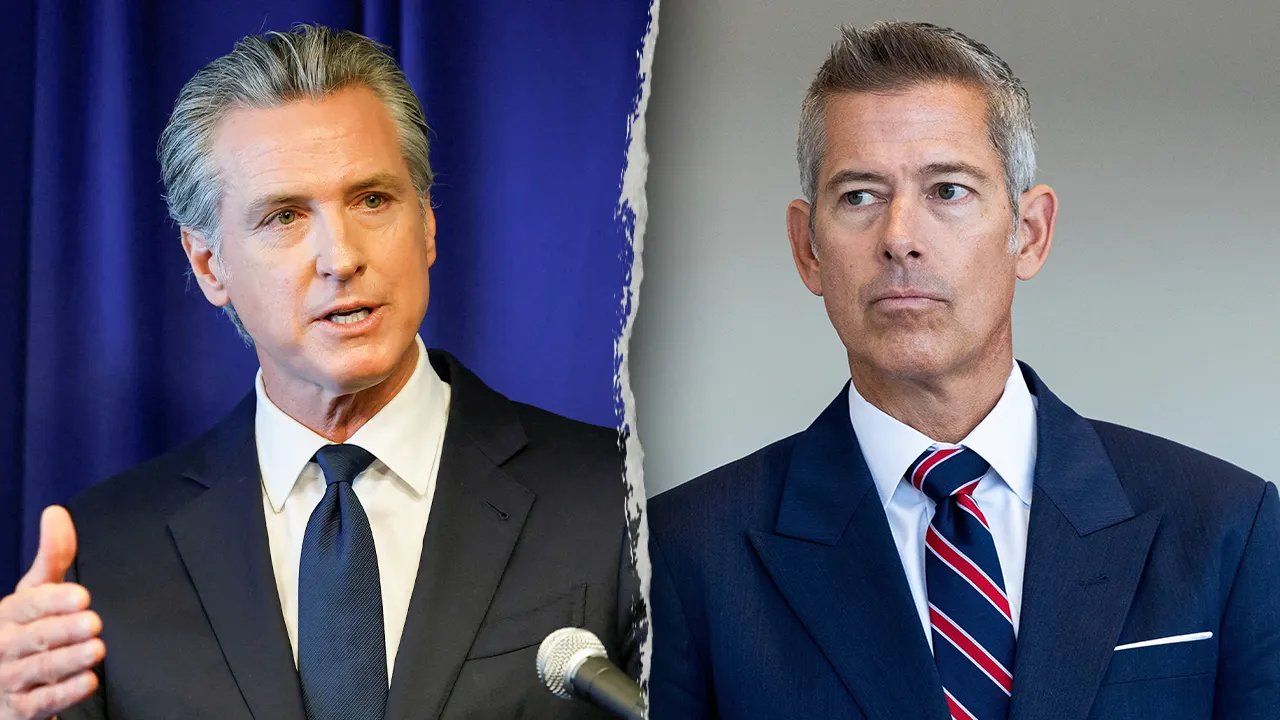
NEWYou can now listen to Fox News articles!
California is set to revoke commercial driver’s licenses (CDLs) issued to 17,000 immigrants after pressure from the Trump administration.
The licenses that are expected to be revoked would have expired after the driver was legally allowed to be in the country.
«After weeks of claiming they did nothing wrong, Gavin Newsom and California have been caught red-handed. Now that we’ve exposed their lies, 17,000 illegally issued trucking licenses are being revoked,» Transportation Secretary Sean Duffy said in a statement. «This is just the tip of the iceberg. My team will continue to force California to prove they have removed every illegal immigrant from behind the wheel of semi-trucks and school buses.»
The Transportation Department said that those impacted by the decision have been notified that their licenses no longer meet federal requirements and will expire in 60 days. However, California Gov. Gavin Newsom’s office said in a post on X that the federal requirements referenced were not in effect when the licenses were issued.
EXPERT REVEALS HOW ILLEGAL IMMIGRANT TRUCKER MAY HAVE GOTTEN COMMERCIAL LICENSE BEFORE FATAL FLORIDA CRASH
California is moving to revoke 17,000 commercial driver’s licenses after pressure from the Trump administration. (Fred Greaves/Reuters; Rachel Wisniewski/Reuters)
In the scathing social media post, Newsom’s office slammed Duffy over the Transportation Department’s statement on the matter, highlighting each point that it deemed to be a «lie.»
The first point that Newsom’s office pushed back on was the department’s assertion that the California Department of Motor Vehicles «admitted to illegally issuing» the 17,000 CDLs in question. Newsom’s office claims that the licenses were withdrawn because they were inconsistent with California law.
Newsom’s office also rejected the department’s statement that the drivers who received the licenses were illegal immigrants, saying that they were present in the U.S. legally and «had been granted work authorization by the federal government.»
Additionally, Newsom’s office disputed the claim that the Federal Motor Carrier Safety Administration’s (FMCSA) analysis showed that «more than one in four of the non-domiciled CDL records sampled in California failed to comply with federal regulations.» The California governor’s office claimed that FMCSA’s analysis was «based on retroactive application of its new rules» and said «FMCSA also faults California for following guidance explicitly approved by DHS.»
Duffy, however, hit back, saying, «We’ve said all along, [DOT] is reprimanding California for violating [FMCSA’s] ORIGINAL rules.»
«My emergency rule came as a consequence in part for California’s total disregard of those federal laws — it was THAT BAD,» Duffy added.
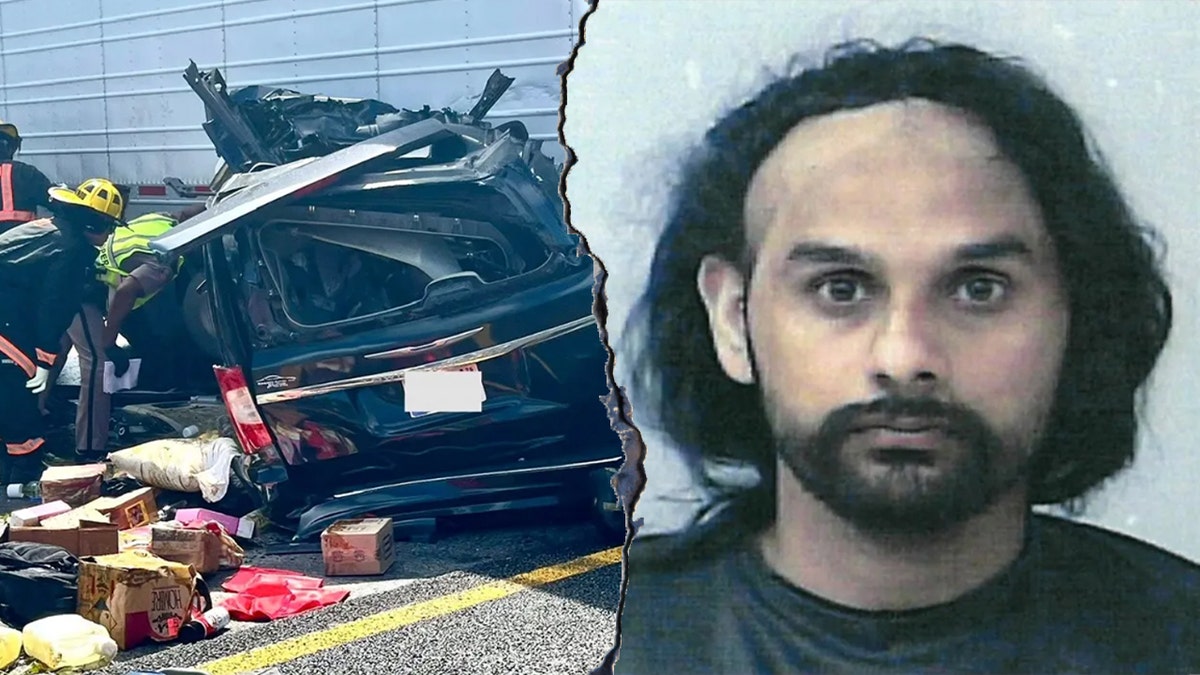
Harjinder Singh, 28, was arrested after allegedly making an unauthorized U-turn in Florida last week that resulted in a crash that left three people dead, officials said. (St. Lucie County Sheriff’s Office)
BLUE STATES DEFLECT BLAME IN TRUMP PROBE AFTER ILLEGAL IMMIGRANT TRUCKER CRASH KILLS 3 IN FLORIDA
California’s move to revoke the licenses came just one day before Harjinder Singh, who crossed into the United States illegally in 2018 and is accused of causing a fatal accident that left three people dead, faced a docket call hearing as the court reviews discovery issues and interpreter concerns.
Singh was charged with three counts of vehicular homicide after he allegedly attempted to make an illegal U-turn through an «Official Use Only» access point in Fort Pierce, Fla. When making the turn, Singh allegedly caused what Homeland Security called a «brutal wreck.» In August, Singh was extradited from California to Florida, where the accident took place.
Just days after the accident, officials investigating the wreck said that Singh failed English and road sign tests.
BLUE STATE INVESTIGATES HOW ILLEGAL IMMIGRANT TRUCKER GOT LICENSE BEFORE DEADLY FLORIDA CRASH
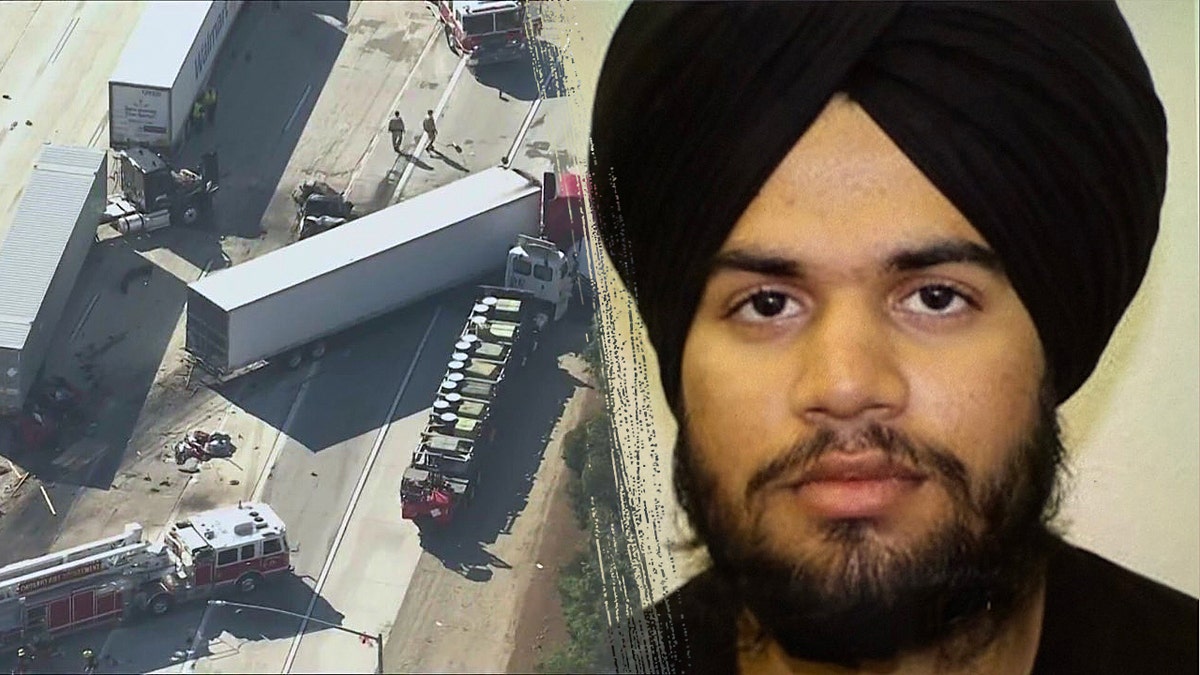
Jashanpreet Singh, an illegal immigrant from India, was arrested in connection with a deadly crash on the I-10 Freeway in San Bernardino County, Calif., on Oct. 21, 2025. Singh is accused of driving under the influence and causing a fiery wreck that killed three people. (Bill Melugin/via X; U.S Immigration and Customs Enforcement (ICE))
«During [FMCSA’s] interview with the driver, investigators administered an English Language Proficiency (ELP) assessment in accordance with FMCSA guidance,» the Department of Transportation said in a statement. «The driver failed the assessment, providing correct responses to just 2 of 12 verbal questions and only accurately identifying 1 of 4 highway traffic signs.»
In another instance, Jashanpreet Singh, an illegal immigrant from India who received a CDL from California, was charged with vehicular manslaughter while intoxicated and driving under the influence after allegedly driving while intoxicated and causing a crash that left three people dead.
Multiple federal law enforcement sources told Fox News that Singh was first encountered by Border Patrol agents in California’s El Centro Sector in March 2022 and released into the interior of the country pending an immigration hearing.
CLICK HERE TO DOWNLOAD THE FOX NEWS APP
Police say Singh never hit the brakes before slamming into the traffic jam, citing toxicology tests that confirmed impairment.
Fox News Digital’s Peter D’Abrosca and Jasmine Baehr and Fox News’ Bill Melugin contributed to this report.
politics,justice department,immigration,illegal immigrants,california
INTERNACIONAL
Ex-Hamas hostage Emily Damari recounts 471 days of survival in Gaza: ‘Everyone needs to know what happened’
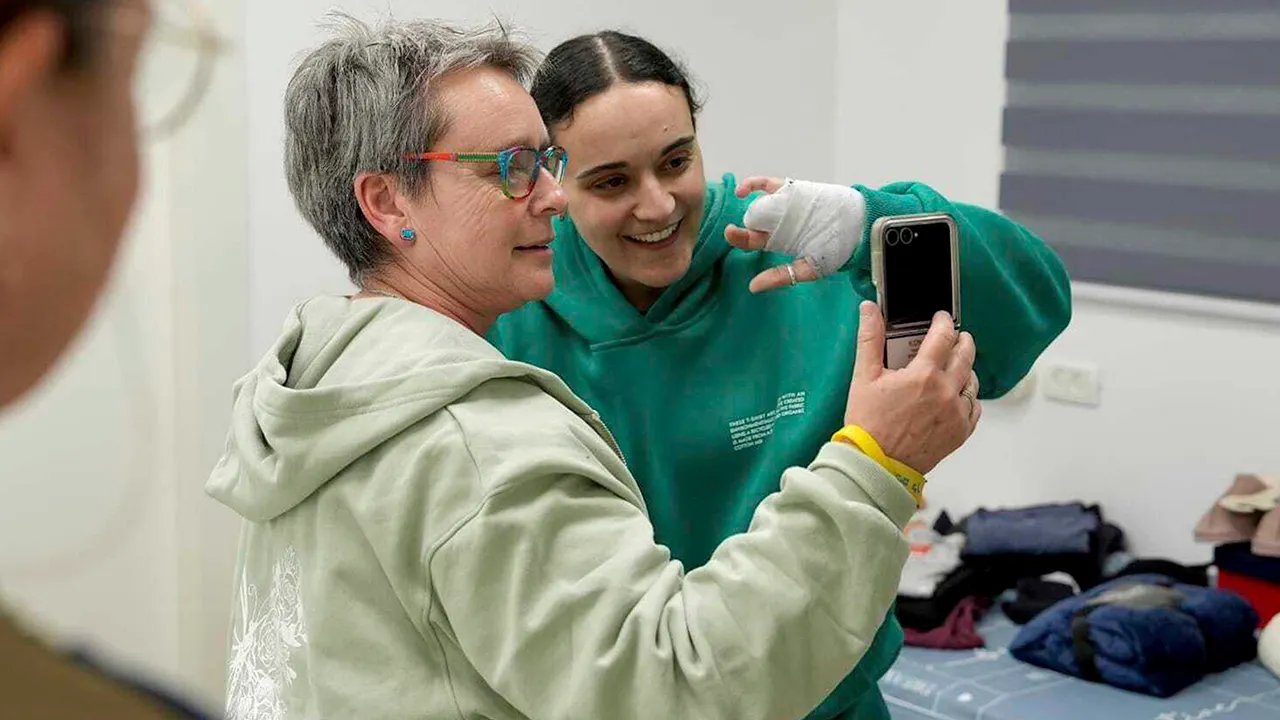
NEWYou can now listen to Fox News articles!
Standing in front of an audience at Temple Emanu-El in New York City, former Hamas hostage Emily Damari received a standing ovation before she even began speaking. The 28-year-old survivor, freed after 471 days in captivity, addressed a packed synagogue alongside actress and activist Noa Tishbi, sharing the experience that has shaped every minute of her life since Oct. 7.
«It was a very important opportunity for me to share my story and the experience I had gone through as a hostage of Hamas in Gaza for 471 days,» Damari told Fox News Digital.
‘They shot my hand. They shot my dog.’
FREED HOSTAGE LAMENTS ISRAELI FANS BEING BARRED FROM UK SOCCER GAME OVER CONCERNS OF PRO-PALESTINIAN PROTESTS
Emily Damari, recently freed from Hamas captivity, speaks at Temple Emanu-El in New York on Nov. 5, 2025. «Even at the hardest moment, I didn’t look down… They have not broken me.» (Fox News)
Damari, whose moment of release went viral after she pushed the terrorist holding her while being transferred to the Red Cross, recounted the moment Hamas terrorists broke into her safe room on Oct. 7. Her story is almost unbearable to hear, yet she smiled through much of it. That refusal to collapse, she said, was deliberate.
«Even at the hardest moment I didn’t look down. I always looked up. I didn’t let the terrorists have the satisfaction of seeing me break. They have not broken me.»
On Oct. 7, Hamas terrorists stormed into her home in Kibbutz Kfar Aza. «They were inside the safe room and shot my hand. The first thing that they did, they shot my hand.» Moments later, they killed her dog. «They’re just looking at her… and immediately they shot her in the head.»
Dragged toward Gaza, she begged them to end her life on the spot. «I understand he’s not going to take me to a hospital in Ashkelon or Tel Aviv… so I’m like, no, no. Please shoot me. I don’t want to be a hostage.»
Instead, she was taken across the border.
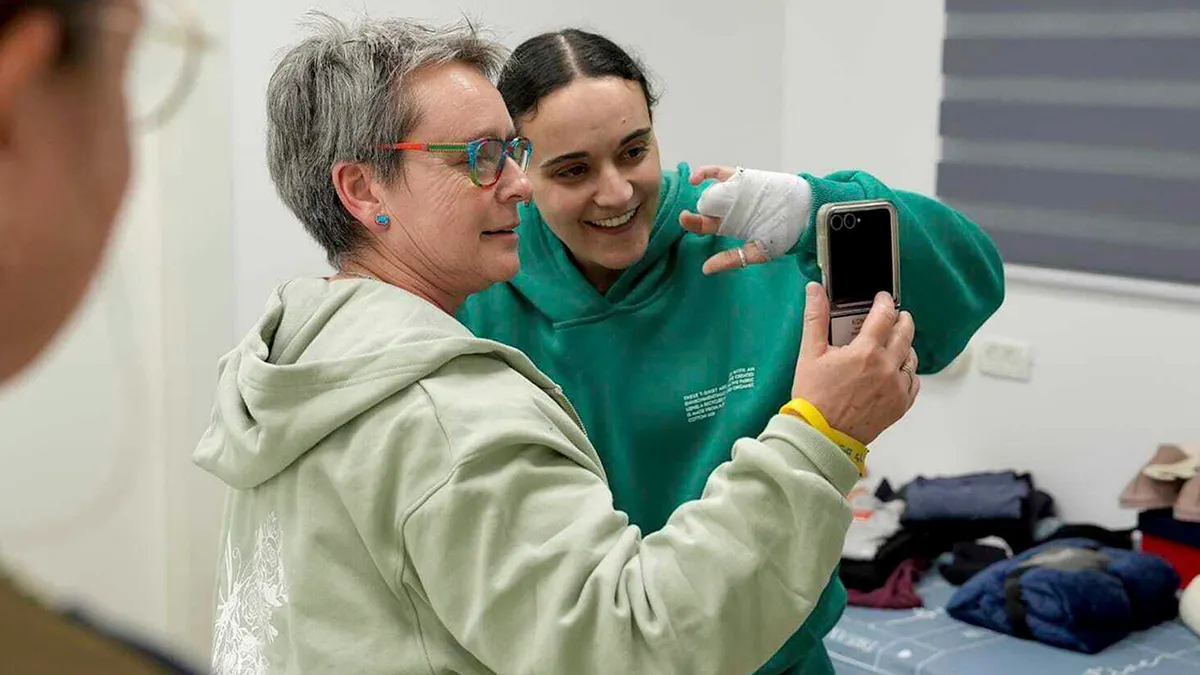
Emily Damari, right, and her mother Mandy are seen near kibbutz Reim, southern Israel after Emily was released from captivity by Hamas terrorists in Gaza, on Sunday, Jan. 19, 2025. (AP/Israeli Army)
She said at Shifa Hospital in Gaza that she «saw many terrorists, dead bodies, hostages and weapons.»
One of the most important messages she wants Americans to understand, she said, is what she witnessed inside Shifa Hospital, widely described abroad as a civilian medical facility is false.
«That hospital… you always see on Al Jazeera, saying there’s a civilian hospital and everything,» she added. «So just so you know… it’s not a civilian hospital.»
«Shifa Hospital is where I was treated by ‘Dr. Hamas’ — that is how the doctor introduced himself to me — and where I saw many terrorists, dead bodies, hostages and weapons. Imagine going to your local hospital and seeing armed terrorists and dead bodies.»

Former Hamas hostage Emily Damari speaks with Noa Tishbi about her life as a Hamas hostage. (Fox News)
For over 15 months, she was held in more than 30 different locations — apartments, schools, tunnels, garages and even a tire storage room — often with days between showers and barely any water. She slept in cramped, filthy spaces, sometimes «without any toilet.»
The most searing memory, she said, came when she was taken deep underground. She was led into a small cage and saw a group of kidnapped girls. «The first thing you see is a 9-year-old girl … without her parents,» she said. «It was one of the most painful things that I saw in captivity.»
«You go to sleep every night … with that fear, that they are going to rape you,» she said. «There is a thing about being a woman in captivity.»
Another moment she shared captured her strong personality. Emily said Hamas repeatedly referred to her as a «prisoner,» and she refused to accept it. «I said, okay, if you call me a prisoner, why do I not get three meals a day? Why don’t I get to speak with my mother? Why don’t I ever get to see the sun?» She told them openly that if she was truly a prisoner, she deserved basic rights. But the terrorists dismissed her.

People walk towards Israeli military helicopters as Romi Gonen, Doron Steinbrecher and Emily Damari, three female hostages who have been held in Gaza since the deadly Oct. 7 2023 attack, return to Israel as part of a ceasefire deal in Gaza between Hamas and Israel, by Israel’s border with Gaza in southern Israel, Jan. 19, 2025. (REUTERS/Amir Cohen)
Damari said Hamas guards routinely played Al Jazeera broadcasts using battery-powered televisions. What she saw stunned her, especially American campus protests.
«I couldn’t believe watching the protests in the USA, especially at Columbia University,» she told Fox News Digital. «Students protesting and people demonstrating for something they knew nothing about.»
As a gay woman who had to hide her identity to stay alive, she immediately noticed LGBTQ activists in the footage. She said she confronted her captors directly.
«I even commented to my captor that if those Queers for Palestine protesters ever got into Gaza, they would never come out,» she told Fox News Digital. «The terrorist captor who was holding me just smirked and agreed.»

Extremists protest against Israel at Columbia University in New York City.
«I feel sorry for all those people for being so poorly informed and not taking the time to understand the truth,» she said.
Damari said she and other hostages survived emotionally by clinging to any sign the world was fighting for them. Weekly demonstrations in Israel were everything.
«We waited every week for that Shabbat … it was one of the biggest lights for us,» she said. «We watched the protest, and we knew they didn’t forget about us … they did whatever they could for us to be released.»
HAMAS CAPTORS ONCE HELD ORDINARY JOBS — ‘TEACHERS AND DOCTORS,’ SAYS EX-ISRAELI HOSTAGE

Freed hostage Emily Damari spoke at Temple Emanu-El in New York, November 5. During her captivity, she didn’t know whether her mother Mandy and brothers Tom and Ben had survived the Hamas attack. (Fox News)
In New York, accompanied by her mother, Mandy, and her brothers, Tom and Ben, she described the agony of not knowing whether her family had survived the massacre in Kfar Aza. Terrorists had reached «very close to my mother’s house» and her brother’s home.
She begged God for a sign her mother was alive. It came only when guards briefly switched on a small TV. «The first thing we saw was someone showing my poster in the Knesset … and I’m like, oh my God, it’s my mom. My mom is alive.»
But she still didn’t know about her brother. She learned the truth only after she crossed back into Israel. «They took me to the IDF, and they said, all your family is fine … my brother is fine,» she recalled in tears. «That was the moment I finally allowed myself to breathe.»
Freedom brought its own weight. Her best friends from Kfar Aza, Gali and Ziv Berman, remained in Gaza until the final hostage deal, brokered by the Trump administration. Emily said their release on Oct. 13 was the moment she truly felt free.
«I didn’t feel comfortable seeing the sunset. I didn’t enjoy anything… while they were still there.»
«Now I’m feeling amazing,» she said. «That was the real happiness that I was searching for.»
Asked what comes next, she did not hesitate to say.
CLICK HERE TO DOWNLOAD THE FOX NEWS APP
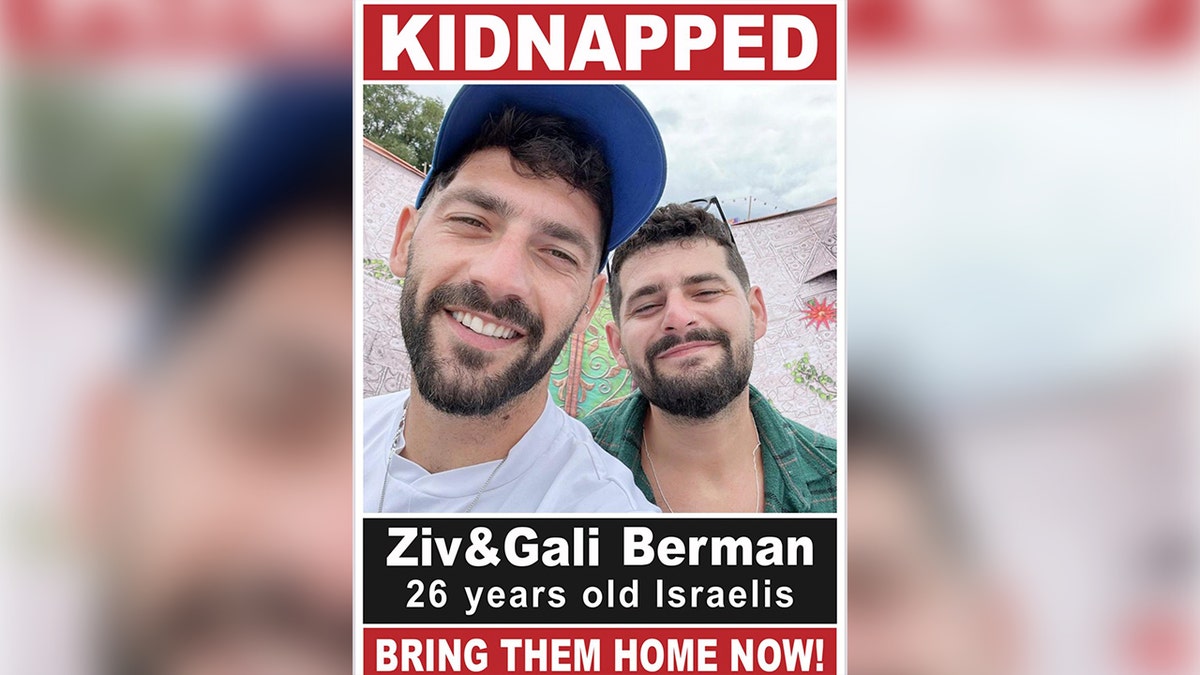
Hamas hostage posters of Gali and Ziv Berman, close friends of Emily Damari who were finally released from captivity last month. «I didn’t feel comfortable to see the sunset. I didn’t enjoy anything… while they were still there,» Damari said. (The Hostages and Missing Families Forum)
«I think there’s a reason that God chose me to have this horrible experience … I have the opportunity to speak with the world … and to share my story,» she said, sharing that she has started writing a book. «Everyone should know everything about what we’ve been through.»
She ended with a plea not to forget the four hostages still held in Gaza, one of whom is reportedly expected to be returned later today. «Everyone should have their dignified burial,» she said.
world,israel,hamas,terrorism
INTERNACIONAL
Si la IA difama a alguien, ¿quién es el responsable?

Los representantes de ventas de Wolf River Electric, un contratista de energía solar de Minnesota, observaron un aumento inusual de contratos cancelados a finales del año pasado. Cuando pidieron explicaciones a los antiguos clientes, las respuestas los dejaron estupefactos.
Los clientes dijeron que se habían echado atrás después de enterarse, por búsquedas en Google, de que la empresa había llegado a un acuerdo con el fiscal general del estado por prácticas de venta engañosas. Pero la empresa nunca había sido demandada por el gobierno, y mucho menos había llegado a un acuerdo en un caso relacionado con tales reclamaciones.
Leé también: OpenAI lanzó GPT-5.1 para que ChatGPT sea más “cálido e inteligente”
La confusión se convirtió en preocupación cuando los directivos de Wolf River lo comprobaron por sí mismos. Los resultados de búsqueda que Gemini, la tecnología de inteligencia artificial de Google, ofrecía en la parte superior de la página, incluían dichas falsedades. Y las menciones a un acuerdo judicial aparecían automáticamente al escribir “Wolf River Electric” en el cuadro de búsqueda.
Ante la acumulación de cancelaciones y el resultado infructuoso de sus intentos por utilizar las herramientas de Google para corregir los problemas, los directivos de Wolf River decidieron que no tenían más remedio que demandar al gigante tecnológico por difamación.
“Invertimos mucho tiempo y energía en forjarnos una buena reputación”, dijo Justin Nielsen, quien fundó Wolf River con tres de sus mejores amigos en 2014 y contribuyó a que se convirtiera en el mayor contratista solar del estado. “Cuando los clientes ven una señal de alerta como esa, es casi imposible recuperarlos”.
Leé también: Condenaron a OpenAI por usar letras de canciones protegidas por derecho de autor para entrenar a ChatGPT
El suyo es uno de al menos seis casos de difamación presentados en Estados Unidos en los últimos dos años por contenidos producidos por herramientas de IA que generan texto e imágenes. Estos argumentan que la tecnología de vanguardia no solo creó y publicó información falsa y perjudicial sobre personas o grupos, sino que, en muchos casos, siguió difundiéndola incluso después de que las empresas que desarrollaron y se benefician de los modelos de IA fueran notificadas del problema.
Entonces: ¿quién es reponsable?
A diferencia de otras demandas por difamación o calumnia, estos casos pretenden definir como difamatorio el contenido que no ha sido creado por seres humanos, un concepto novedoso que ha intrigado a algunos expertos jurídicos.
“No hay duda de que estos modelos pueden publicar afirmaciones perjudiciales”, dijo Eugene Volokh, destacado estudioso de la Primera Enmienda en la Universidad de California en Los Ángeles. En 2023, Volokh dedicó un número entero de su publicación, Journal of Free Speech Law, a la cuestión de la difamación por parte de la IA. “La pregunta”, dijo Volokh, “es quién es responsable de ello”.
Uno de los primeros casos de difamación por IA se presentó en Georgia en 2023. El demandante, Mark Walters, locutor de radio y defensor de la Segunda Enmienda, alegó que el chatbot ChatGPT había dañado su reputación cuando respondió a una consulta de un periodista sobre los derechos de las armas afirmando falsamente que Walters había sido acusado de malversación de fondos.
Leé también: Una madre denunció que el chatbot de Elon Musk le pidió a su hijo de 10 años que comparta fotos suyas desnudo
Una tarea fundamental en muchos casos de difamación en Estados Unidos es demostrar la intención. Pero como es imposible saber qué ocurre dentro de los algoritmos que impulsan a los modelos de IA como ChatGPT, la demanda -y otras similares- intentaron culpar a la empresa que escribió el código, en este caso OpenAI.
“Frankenstein no puede crear un monstruo que vaya por ahí asesinando gente y luego afirmar que no tuvo nada que ver con eso”, dijo John Monroe, abogado de Walters.
El caso de Walters fue desestimado en mayo, mucho antes de llegar a juicio. Entre otras razones, el tribunal señaló que el periodista había admitido que no se fiaba de la afirmación de ChatGPT y comprobó rápidamente que no era cierta. Esa cuestión -si es probable que terceros se convenzan de que el contenido supuestamente difamatorio es cierto- es crucial en estos casos.
“Si la persona que lee una declaración impugnada no cree subjetivamente que sea cierta, entonces la afirmación no es difamatoria”, escribió la jueza Tracie Cason en su sentencia. OpenAI no respondió a la solicitud de comentarios.
¿La IA puede tener mala intención?
Hasta la fecha, ningún caso de difamación por IA en Estados Unidos parece haber llegado a un jurado, pero al menos uno, presentado en abril contra Meta por Robby Starbuck, un influente de derecha conocido por sus campañas contra los programas de diversidad, equidad e inclusión, ha llegado a un acuerdo.
Starbuck alegó que, mientras navegaba por X, había encontrado una imagen que contenía información falsa sobre él, generada por Llama, uno de los chatbots de IA de Meta. El texto de la imagen afirmaba que Starbuck estuvo en el Capitolio de Estados Unidos durante los disturbios del 6 de enero de 2021, y que tenía vínculos con la teoría de la conspiración QAnon. Starbuck dijo que ese día estaba en su casa de Tennessee y que no tenía nada que ver con QAnon.
Meta llegó a un acuerdo en agosto sin responder formalmente a la demanda. Como parte del acuerdo, la empresa contrató a Starbuck como asesor para controlar la IA de Meta.
“Desde que empezamos a colaborar con Robby en estos temas importantes, Meta ha logrado avances significativos para mejorar la precisión de la IA de Meta y mitigar los prejuicios ideológicos y políticos”, dijo Meta en un comunicado en aquel momento. La empresa se negó a revelar otros términos del acuerdo o si Starbuck cobró por su labor de asesoramiento.
El mes pasado, Starbuck también demandó a Google por su IA. En la demanda por difamación, en la que pedía 15 millones de dólares por daños y perjuicios, afirmaba que los modelos de lenguaje de gran tamaño de Google -la tecnología que ayuda a impulsar los chatbots-habían hecho declaraciones manifiestamente falsas sobre él. Esta vez, sin embargo, alegó que los errores eran el “resultado deliberado de la animadversión política incorporada a su algoritmo”.
Google aún no ha respondido formalmente a la demanda, pero Jose Castañeda, vocero de la empresa, dijo que la mayoría de las afirmaciones de Starbuck databan de 2023 y se abordaron en su momento. Y añadió: “Como todo el mundo sabe, si eres lo bastante creativo, puedes incitar a un chatbot a decir algo engañoso”.
Un daño traumático
Dave Fanning, un popular DJ y presentador de programas de entrevistas irlandés, no necesitó dar ninguna instrucción para descubrir lo que calificó de material difamatorio sobre él en internet. El contenido, que aparecía en el portal web MSN de Microsoft, era un artículo con su fotografía en la parte superior y el titular “Prominente locutor irlandés se enfrenta a juicio por presunta conducta sexual inapropiada”.
Fanning, que no ha sido acusado de conducta sexual inapropiada, se enteró después de que varias personas se pusieron en contacto con él para preguntarle por las acusaciones. Finalmente, descubrió que un sitio de noticias con sede en India había utilizado un chatbot de inteligencia artificial para generar el artículo y había añadido su foto junto al texto. Luego Microsoft publicó el artículo, que fue visible brevemente para cualquier persona en Irlanda que iniciara sesión en MSN o utilizara el navegador Microsoft Edge.
A principios del año pasado, Fanning demandó a Microsoft y al medio de comunicación indio ante un tribunal irlandés, una de las pocas demandas por difamación de la IA que se han presentado fuera de Estados Unidos.
Microsoft declinó hacer comentarios sobre el caso pendiente, que Fanning dijo que quería llevar a juicio. “Lo que hizo Microsoft fue traumatizante, y el trauma se convirtió en ira”, dijo.
(The New York Times ha demandado a Microsoft y OpenAI, alegando infracción de derechos de autor sobre contenido de noticias relacionadas con los sistemas de IA. Ambas compañías han negado las acusaciones de la demanda).
Nina Brown, profesora de comunicaciones de la Universidad de Siracusa y especialista en derecho de los medios de comunicación, afirmó que preveía que pocos de estos casos, si es que alguno, llegarían a juicio. Un veredicto que declarara que una empresa es responsable de los resultados de su modelo de IA, dijo, podría provocar una enorme avalancha de litigios por parte de otros que descubrieran falsedades sobre sí mismos.
“Sospecho que si hay una demanda por difamación por parte de la IA en la que el demandado sea vulnerable, desaparecerá: las empresas llegarán a un acuerdo”, dijo Brown. “No quieren correr el riesgo”.
Perjuicios importantes
Ella, Volokh y otros expertos jurídicos dijeron que el caso de Wolf River parecía especialmente sólido, en parte porque la empresa ha podido documentar pérdidas específicas provocadas por la falsedad.
En su denuncia, citaba 388.000 dólares en contratos rescindidos. Vladimir Marchenko, director ejecutivo, dijo en una entrevista que la empresa también había perdido clientes nuevos.
“Hemos descubierto que algunos competidores mencionan las falsas afirmaciones del fiscal general en las consultas con posibles clientes para convencerlos de que no recurran a nosotros”, dijo. Señaló que también había descubierto publicaciones en Reddit que citaban los falsos resultados de Google. Uno calificaba a Wolf River de “posible empresa diabólica”.
La empresa, en correspondencia con Google, dijo que había perdido casi 25 millones de dólares en ventas en 2024 y que solicitaba una indemnización total por daños y perjuicios de al menos 110 millones de dólares. La demanda está en suspenso mientras un juez federal decide si conserva el caso o lo devuelve al tribunal estatal, donde se presentó en marzo.
Un factor que podría jugar a favor de Wolf River es que probablemente no se le catalogue como una figura pública. Se trata de una distinción importante porque, en Estados Unidos, las figuras privadas tienen un umbral más bajo para demostrar que se ha producido difamación: solo tienen que demostrar que Google actuó con negligencia, y no con lo que se conoce como “indiferencia temeraria” hacia la verdad.
Castañeda, el portavoz de Google, reconoció en un comunicado que “con cualquier tecnología nueva, pueden producirse errores”, y señaló que “en cuanto nos enteramos del problema, actuamos rápidamente para solucionarlo”.
Sin embargo, todavía el lunes, una búsqueda en Google de “queja sobre wolf river electric” arrojaba un resultado que decía que “la empresa también se enfrenta a una demanda del fiscal general de Minnesota relacionada con sus prácticas de venta” y sugería a los clientes que “presentaran una queja ante la oficina del fiscal general de Minnesota, puesto que ya están implicados con la empresa”.
Marchenko, quien emigró de niño a Minnesota desde Ucrania y jugó al hockey juvenil con Nielsen, dijo que le preocupaba que la empresa pudiera quebrar si los resultados de la IA no cambiaban.
“No tenemos un plan B”, dijo. “Empezamos esto desde cero. Tenemos nuestra reputación, y eso es todo”.
Por Ken Bensinger cubre a los medios de comunicación y a la política para el Times.
The New York Times

 CHIMENTOS2 días ago
CHIMENTOS2 días agoWada Nara se despidió de sus hijas con un desgarrador mensaje al entregárselas a Mauro Icardi: «Que la pasen hermoso»

 POLITICA3 días ago
POLITICA3 días agoAxel Kicillof prometió no subir impuestos, pero montó un mecanismo de recaudación con Ingresos Brutos

 ECONOMIA1 día ago
ECONOMIA1 día agoGuiño al crédito fintech: el BCRA autorizará el débito directo de cuotas, prohibido durante el Gobierno anterior


























